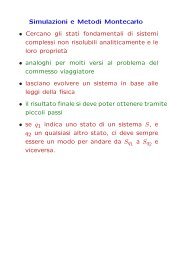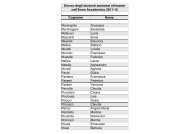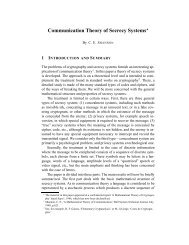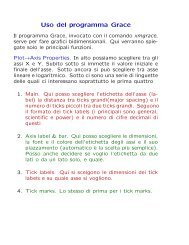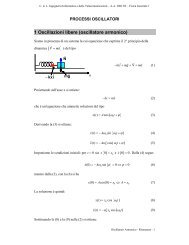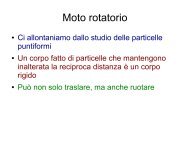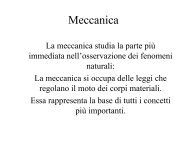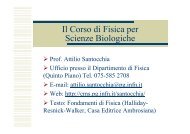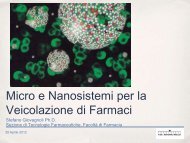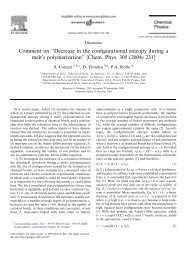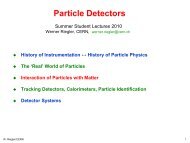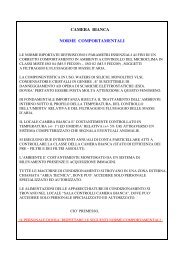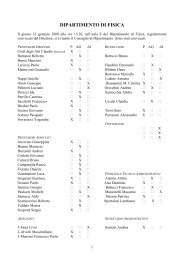x - Fisica
x - Fisica
x - Fisica
Create successful ePaper yourself
Turn your PDF publications into a flip-book with our unique Google optimized e-Paper software.
*<br />
IP2<br />
IP5<br />
Bernhard Holzer,<br />
CERN-LHC<br />
IP1<br />
IP8
A Bit of History<br />
A Bit of Theory<br />
A Bit of Reality
1.) Electrostatic Machines:<br />
The Cockcroft-Walton Generator<br />
1928: Encouraged by Rutherford Cockcroft and Walton<br />
start the design & construction of a high voltage<br />
generator to accelerate a proton beam<br />
1932: First particle beam (protons) produced for<br />
nuclear reactions: splitting of Li-nuclei with<br />
a proton beam of 400 keV<br />
Particle source: Hydrogen discharge tube<br />
on 400 kV level<br />
Accelerator: evacuated glas tube<br />
Target: Li-Foil on earth potential<br />
Technically: rectifier circuit, built of capacitors<br />
and diodes (Greinacher)<br />
robust, simple, on-knob machines<br />
largely used in history as pre-accelerators for<br />
proton and ion beams<br />
recently replaced by modern structures (RFQ)
creating high voltages by mechanical<br />
transport of charges<br />
* Terminal Potential: U ≈ 12 ...28 MV<br />
using high pressure gas to suppress discharge ( SF 6 )<br />
Problems: * Particle energy limited by high voltage discharges<br />
* high voltage can only be applied once per particle ...<br />
... or twice ?
The „Tandem principle“: Apply the accelerating voltage twice ...<br />
... by working with negative ions (e.g. H - ) and<br />
stripping the electrons in the centre of the<br />
structure<br />
Example for such a „steam engine“: 12 MV-Tandem van de Graaff<br />
Accelerator at MPI Heidelberg
... and how it looks inside<br />
“Vivitron” Strassbourg<br />
60 tons of SF 6 to suppress discharges<br />
Accelerating structure and<br />
vacuum beam pipe<br />
7
The Principle of the “Steam Engine”:<br />
Mechanical Transport of Charge via a rotating<br />
chain or belt<br />
stripping foils: 1500 Å
€<br />
1928, Wideroe: how can the acceleration voltage be applied several times<br />
to the particle beam<br />
schematic Layout:<br />
+ - + - + - +<br />
Energy gained after n acceleration gaps n number of gaps between the drift tubes<br />
E n = n * q*U 0 *sinψs q charge of the particle<br />
U0 Peak voltage of the RF System<br />
ΨS synchronous phase of the particle<br />
* acceleration of the proton in the first gap<br />
* voltage has to be „flipped“ to get the right sign in the second gap RF voltage<br />
shield the particle in drift tubes during the negative half wave of the RF voltage
Wideroe-Structure: the drift tubes<br />
shielding of the particles during the negative<br />
half wave of the RF<br />
Time span of the negative half wave: τ RF /2<br />
Length of the Drift Tube:<br />
Kinetic Energy of the Particles<br />
€<br />
Alvarez-Structure: 1946, surround the whole<br />
structure by a rf vessel<br />
€<br />
l i = v i * τ rf<br />
2<br />
E i = 1 2<br />
mv<br />
2<br />
€<br />
Energy: ≈ 20 MeV per Nucleon β ≈ 0.04 … 0.6, Particles: Protons/Ions<br />
€<br />
→ v i = 2Ei m<br />
l i = 1<br />
ν rf<br />
* i * q*U 0*sinψ s<br />
2m<br />
valid for non relativistic particles ...<br />
10
Example: DESY Accelerating structure of the Proton Linac<br />
Beam energies<br />
1.) reminder of some relativistic formula<br />
rest energy<br />
total energy momentum<br />
kinetic energy<br />
€<br />
E = γ * E 0 = γ * m 0 c 2
GSI: Unilac, typical Energie ≈ 20 MeV per<br />
Nukleon, β ≈ 0.04 … 0.6,<br />
Protons/Ions, ν = 110 MHz<br />
Energy Gain per „Gap“:<br />
Application: until today THE standard proton / ion pre-accelerator<br />
CERN Linac 4 is being built at the moment
4.) The Cyclotron: (Livingston / Lawrence ~1930)<br />
Idea: Bend a Linac on a Spiral<br />
Application of a constant magnetic field<br />
keep B = const, RF = const<br />
Lorentzforce<br />
<br />
F = q * (v →<br />
× B →<br />
) = q * v * B<br />
circular orbit<br />
q *v * B =<br />
revolution frequency<br />
ω z = q<br />
m * B z<br />
m * v 2<br />
R<br />
→ B * R = p /q<br />
increasing radius for<br />
increasing momentum<br />
Spiral Trajectory<br />
the cyclotron (rf-) frequency<br />
is independent of the momentum
€<br />
Beam Energy<br />
... so sorry, here we need help from Albert:<br />
v/c<br />
1<br />
0.9<br />
0.8<br />
0.7<br />
0.6<br />
0.5<br />
0.4<br />
0.3<br />
0.2<br />
0.1<br />
0<br />
γ = E total = 2<br />
mc<br />
1<br />
1−<br />
v 2<br />
c 2<br />
€<br />
0 500 1000 1500 2000 2500 3000 3500 4000 4500 5000<br />
Linac 2<br />
v<br />
c<br />
= 1− mc 2<br />
kinetic energy of a proton (MeV)<br />
PSB<br />
E 2<br />
CERN Accelerators<br />
kin. Energy γ<br />
Linac 2 60 MeV 1.06<br />
PS 26 GeV 27<br />
SPS 450 GeV 480<br />
LHC 7 TeV 7460<br />
remember: proton mass = 938 MeV
Cyclotron:<br />
Sector<br />
Magnet<br />
modern trends: Problem: m ≠ const.<br />
non relativistic machine<br />
Synchro-Cyclotron: RF frequency is tuned during<br />
acceleration cycle<br />
Isochron-Cyclotron: Increase of magnetic field according to γ<br />
Rf-system<br />
Rf-system<br />
€<br />
E ≈ A *100MeV<br />
court: R. iThemba Thomae<br />
Cyclotrons<br />
(Capetown Area)
5.) The Betatron: Wideroe 1928/ Kerst 1940<br />
…apply the transformer principle to an electron beam: no RF system needed,<br />
changing magnetic B field<br />
Idea: a time varying magnetic field induces a voltage that will accelerate the particles<br />
Farady induction law<br />
circular orbit<br />
magnetic flux through this orbit area<br />
schematic design<br />
B a<br />
B g
induced electric field<br />
€<br />
∫<br />
<br />
E ds = <br />
E * 2πr<br />
= −Φ •<br />
force acting on the particle:<br />
The increasing momentum of the particle €<br />
has to be accompanied by a rising magnetic<br />
guide field:<br />
⇒ <br />
E = −πr2 * B •<br />
2πr<br />
p •<br />
a<br />
= − <br />
E e = 1<br />
2 B•<br />
a r<br />
= − 1<br />
2 B•<br />
a r<br />
robust, compact machines,<br />
Energy ≤ 300...500 MeV,<br />
limit: Synchrotron radiation
6.) Synchrotrons / Storage Rings / Colliders:<br />
Wideroe 1943, McMillan, Veksler 1944,<br />
Courant, Livingston, Snyder 1952<br />
Idea: define a circular orbit of the particles,<br />
keep the beam there during acceleration,<br />
put magnets at this orbit to guide and focus<br />
Advanced Photon Source,<br />
Berkley
7.) Electron Storage Rings<br />
Production of Synchrotron Light<br />
P s = e2 c<br />
6πε 0<br />
ΔE =<br />
ω c =<br />
*<br />
e 2<br />
3ε 0 m 0c 2<br />
3cγ 3<br />
2R<br />
1<br />
m0c 2 ( ) 4<br />
( ) 4<br />
E 4<br />
R<br />
E 4<br />
R 4<br />
Radiation Power<br />
Energy Loss per turn<br />
„typical Frequency“<br />
of emitted light
The electromagnetic Spectrum:<br />
having a closer look at the sun ...<br />
Light:<br />
λ ≈ 400 nm … 800 nm<br />
1 Oktave
Analysis of Cell structures<br />
Structure of a Ribosom<br />
Ribosomen are responsible for the protein production<br />
in living cells.<br />
The structure of these Ribosom molecules can be<br />
analysed using brilliant synchrotron light from<br />
electron storage rings<br />
(Quelle: Max-Planck-Arbeitsgruppen für<br />
Strukturelle Molekularbiologie)<br />
Angiographie<br />
x-ray method applicable for the imaging of coronar<br />
heart arteria
Beam energies<br />
8.) Synchrotrons as Collider Rings (1960 ... ):<br />
1.) reminder of some relativistic formula<br />
€<br />
total energy<br />
€<br />
cp = E 2 2 4<br />
− m0c = γm0c 2 ( ) 2 − m0c 2 ( ) 2 = γ 2 −1m 0c 2<br />
2.) energy balance of colliding particles<br />
rest energy of a particle<br />
E 2 = p 2 c 2 2 4<br />
+ m0 c<br />
in exactly the same way we define a center of mass energy of a system of particles:<br />
€<br />
2<br />
E 0 = m0c 2 ( ) 2<br />
= E 2 − p 2 c 2
two colliding particles<br />
Example 1): proton beam on fixed proton<br />
remember:
Descovery of the Quarks: electron beam on fixed proton / neutron target<br />
Taylor/Kendall/Friedman: Discovery of the<br />
Quark structure of protons and neutrons<br />
1966-1978 ..... 1990 Knobel Price
€<br />
€<br />
Example 2 : particle anti-particle collider<br />
* store both counter rotating particle beams in the same magnet lattice<br />
* no conservation of quantum numbers required<br />
2<br />
E cm = ( γ1m1 + γ 2m2) 2<br />
c 4 − ( cp1 + cp2) 2<br />
E cm = 2γmc 2<br />
Colliders: * working at highest energies (“cm”)<br />
* store the particles for long time in an accelerator<br />
* bring two beams into collision<br />
* particle density !!<br />
* preparation / technical design / field qualities are extreme<br />
1979 PETRA Collider at DESY<br />
discovery of the gluon
Structure of Matter<br />
9.) Storage Rings<br />
for Structure Analysis<br />
synchrotron light: nm<br />
electron scattering: Å ... 10<br />
de Broglie:<br />
λ = h<br />
p<br />
= ch<br />
E<br />
-18 m<br />
E ≈ pc
10.) Storage Rings to Explain the Universe<br />
Precision Measurements of the Standard Model,<br />
Search for Higgs, Supersymmetry, Dark Matter<br />
Physics beyond the Standard Model
*<br />
IP2<br />
IP5<br />
Bernhard Holzer,<br />
CERN-LHC<br />
IP1<br />
IP8
old greek dictum of wisdom:<br />
if you are clever, you use magnetic fields in an accelerator wherever<br />
it is possible.<br />
The ideal circular orbit<br />
condition for circular orbit:<br />
Lorentz force<br />
centrifugal force<br />
ρ<br />
θ ●<br />
s<br />
circular coordinate system<br />
B ρ = "beam rigidity"
Dipole Magnets:<br />
define the ideal orbit<br />
homogeneous field created<br />
by two flat pole shoes<br />
Normalise magnetic field to momentum:<br />
Example LHC:<br />
convenient units:
ule of thumb:<br />
2πρ = 17.6 km<br />
≈ 66%<br />
ds<br />
field map of a storage ring dipole magnet<br />
„normalised bending strength“<br />
α<br />
ρ
The Problem:<br />
LHC Design Magnet current: I=11850 A<br />
and the machine is 27 km long !!!<br />
Ohm’s law:<br />
U = R * I, P = R * I 2<br />
Problem:<br />
reduce ohmic losses to the absolute minimum<br />
€<br />
The Solution:<br />
super conductivity
Super Conductivity<br />
LHC 1.9 K cryo plant<br />
discovery of sc. by<br />
H. Kammerling Onnes,<br />
Leiden 1911
Superfluid helium:<br />
1.9 K cryo system<br />
Phase diagramm of Helium<br />
thermal conductivity of fl. Helium<br />
in supra fluid state
Heat<br />
exchanger<br />
Beam pipe<br />
(10 15 H2/m 3 )<br />
Vacuum<br />
vessel (10 -6<br />
mbar)<br />
Iron<br />
yoke<br />
Thermal<br />
shield<br />
Quadrupole<br />
bus-bars<br />
Superconducting<br />
coils<br />
Collars<br />
Beam<br />
screen<br />
Dipole<br />
bus-bars<br />
L ~ 15 m<br />
8.3 T, 11.87 kA<br />
T = 1.9 K, ~27.5 ton<br />
6 µm Ni-Ti filament<br />
required field quality:<br />
ΔB/B=10 -4<br />
1 mm
2.) Focusing Properties – Transverse Beam Optics
2.) Focusing Properties – Transverse Beam Optics<br />
classical mechanics:<br />
pendulum<br />
general solution: free harmonic oszillation<br />
there is a restoring force, proportional<br />
to the elongation x:<br />
Storage Ring: we need a Lorentz force that rises as a function of<br />
the distance to ........ ?<br />
................... the design orbit
equired: focusing forces to keep trajectories in vicinity of the ideal orbit<br />
linear increasing Lorentz force<br />
linear increasing magnetic field<br />
normalised quadrupole field:<br />
simple rule:<br />
what about the vertical plane:<br />
... Maxwell<br />
⇒<br />
LHC main quadrupole magnet<br />
∂By ∂x = ∂Bx ∂y<br />
= g
normalise magnet fields to momentum<br />
(remember: B*ρ = p / q )<br />
Dipole Magnet Quadrupole Magnet
only terms linear in x, y taken into account dipole fields<br />
quadrupole fields<br />
Separate Function Machines:<br />
Split the magnets and optimise<br />
them according to their job:<br />
bending, focusing etc<br />
Example:<br />
heavy ion storage ring TSR<br />
* man sieht nur<br />
dipole und quads linear
€<br />
*<br />
*<br />
Equation for the horizontal motion:<br />
x ′ + x ( 1<br />
+ k) = 0<br />
2<br />
ρ<br />
x = particle amplitude<br />
x’ = angle of particle trajectory (wrt ideal path line)<br />
Equation for the vertical motion:<br />
′ ′<br />
y − k y = 0<br />
no dipoles … in general …<br />
quadrupole field changes sign<br />
ρ<br />
θ ●<br />
s<br />
y<br />
x<br />
●<br />
x<br />
y
Differential Equation of harmonic oscillator … with spring constant K<br />
Ansatz:<br />
Define … hor. plane: K= 1/ρ 2 + k<br />
… vert. Plane: K = - k<br />
Hor. Focusing Quadrupole K > 0:<br />
For convenience expressed in matrix formalism:
hor. defocusing quadrupole:<br />
Ansatz: Remember from school<br />
€<br />
drift space:<br />
K = 0<br />
x(s) = x ′ 0 * s<br />
s = 0<br />
! with the assumptions made, the motion in the horizontal and vertical planes are<br />
independent „ ... the particle motion in x & y is uncoupled“<br />
s = s1
Transformation through a system of lattice elements<br />
€<br />
combine the single element solutions by multiplication of the matrices<br />
x(s)<br />
0<br />
typical values<br />
in a strong<br />
foc. machine:<br />
x ≈ mm, x´ ≤ mrad<br />
⎛ x<br />
⎜<br />
⎝ x'<br />
⎞<br />
⎟ = M(s2,s 1) *<br />
⎠ s2<br />
x ⎛<br />
⎜<br />
⎝ x'<br />
⎞<br />
⎟<br />
⎠ s1<br />
in each accelerator element the particle trajectory corresponds to the movement of a<br />
harmonic oscillator „<br />
focusing lens<br />
court. K. Wille<br />
dipole magnet<br />
defocusing lens<br />
s
Tune: number of oscillations per turn<br />
64.31<br />
59.32<br />
Relevant for beam stability:<br />
non integer part<br />
LHC revolution frequency: 11.3 kHz
First turn steering "by sector:"<br />
One beam at the time<br />
Beam through 1 sector (1/8 ring),<br />
correct trajectory, open collimator and move on.
Question: what will happen, if the particle performs a second turn ?<br />
x<br />
0<br />
... or a third one or ... 10 10 turns<br />
s
Bunch in a Storage Ring
Astronomer Hill:<br />
differential equation for motions with periodic focusing properties<br />
„Hill‘s equation“<br />
equation of motion:<br />
Example: particle motion with<br />
periodic coefficient<br />
restoring force ≠ const, we expect a kind of quasi harmonic<br />
k(s) = depending on the position s oscillation: amplitude & phase will depend<br />
k(s+L) = k(s), periodic function on the position s in the ring.
„it is convenient to see“<br />
Ansatz:<br />
... after some beer ... general solution of Mr Hill<br />
can be written in the form:<br />
ε, Φ = integration constants<br />
determined by initial conditions<br />
β(s) periodic function given by focusing properties of the lattice ↔ quadrupoles<br />
ε beam emittance = woozilycity of the particle ensemble, intrinsic beam parameter,<br />
cannot be changed by the foc. properties.<br />
scientifiquely spoken: area covered in transverse x, x´ phase space … and it is<br />
constant !!!<br />
Ψ(s) = „phase advance“ of the oscillation between point „0“ and „s“ in the lattice.<br />
For one complete revolution: number of oscillations per turn „Tune“
€<br />
Amplitude of a particle trajectory:<br />
x(s) = ε * β(s) * cos(ψ(s) + ϕ)<br />
Maximum size of a particle amplitude<br />
β determines the beam size<br />
( ... the envelope of all particle<br />
trajectories at a given position<br />
“s” in the storage ring.<br />
It reflects the periodicity of the<br />
magnet structure.
7.) Beam Emittance and Phase Space Ellipse<br />
●<br />
●<br />
●<br />
x´<br />
●<br />
●<br />
●<br />
x<br />
x(s)<br />
Liouville: in reasonable storage rings<br />
area in phase space is constant.<br />
A = π*ε=const<br />
ε beam emittance = woozilycity of the particle ensemble, intrinsic beam parameter,<br />
cannot be changed by the foc. properties.<br />
Scientifiquely spoken: area covered in transverse x, x´ phase space … and it is constant !!!<br />
s
… and now the ellipse:<br />
note for each turn x, x´at a given position „s 1“ and plot in the<br />
phase space diagram
single particle trajectories, N ≈ 10 11 per bunch<br />
€<br />
LHC:<br />
β =180m<br />
ε = 5 *10 −10 m rad<br />
Gauß<br />
Particle Distribution:<br />
particle at distance 1 σ from centre<br />
↔ 68.3 % of all beam particles<br />
aperture requirements: r 0 = 12 * σ
1952: Courant, Livingston, Snyder:<br />
Theory of strong focusing in particle beams
Recapitulation: ...the story with the matrices !!!<br />
Equation of Motion:<br />
… hor. plane:<br />
… vert. Plane:<br />
Solution of Trajectory Equations
€<br />
The angle run out in one revolution<br />
must be 2π, so for a full circle<br />
α = Bdl ∫<br />
= 2π<br />
B ρ<br />
∫ Bdl = 2π p<br />
q<br />
p = momentum of the particle,<br />
ρ = curvature radius<br />
Bρ= beam rigidity<br />
… defines the integrated dipole field around the machine.
Example LHC:<br />
7000 GeV Proton storage ring<br />
dipole magnets N = 1232<br />
l = 15 m<br />
q = +1 e
F<br />
o<br />
D<br />
o<br />
MQ: main quadrupole<br />
equipped with additional corrector coils<br />
MB: main dipole<br />
MQ: main quadrupole<br />
MQT: Trim quadrupole<br />
MQS: Skew trim quadrupole<br />
MO: Lattice octupole (Landau damping)<br />
MSCB: Skew sextupole<br />
Orbit corrector dipoles<br />
MCS: Spool piece sextupole<br />
MCDO: Spool piece 8 / 10 pole<br />
BPM: Beam position monitor + diagnostics
A magnet structure consisting of focusing and defocusing quadrupole lenses in<br />
alternating order with nothing in between.<br />
(Nothing = elements that can be neglected on first sight: drift, bending magnets,<br />
RF structures ... and especially experiments...)<br />
Starting point for the calculation: in the middle of a focusing quadrupole<br />
Phase advance per cell µ = 45°,<br />
calculate the twiss parameters for a periodic solution
At the end of a long symmetric<br />
drift space the beta function<br />
reaches its maximum value in the<br />
complete lattice.<br />
-> here we get the largest beam<br />
dimension.<br />
-> keep l as small as possible<br />
l l<br />
β 0<br />
7 sigma beam size inside a mini beta quadrupole
Example: Luminosity optics at LHC: β * ... unfortunately ... in general<br />
high energy detectors that are<br />
installed in that drift spaces = 55 cm<br />
are a little bit bigger than a few centimeters ...<br />
and keep the distance “s” as small as possible.<br />
for smallest β max we have to limit the overall length
production rate of events<br />
is determined by the<br />
cross section Σ react<br />
and a parameter L that is given<br />
by the design of the accelerator:<br />
… the luminosity
10.) Luminosity<br />
Example: Luminosity run at LHC<br />
p1-Bunch<br />
IP<br />
10 11 particles<br />
p2-Bunch<br />
± σ<br />
10 11 particles
A mini-β insertion is always a kind of special symmetric drift space.<br />
greetings from Liouville<br />
the smaller the beam size<br />
the larger the bam divergence<br />
●<br />
●<br />
●<br />
x´<br />
●<br />
●<br />
●<br />
x
Mini-β Insertions: some guide lines<br />
8 individually<br />
powered quad<br />
magnets are<br />
needed to match<br />
the insertion<br />
( ... at least)
The LHC Insertions<br />
mini β optics<br />
ATLAS<br />
R1<br />
IP1 TAS*<br />
Inner<br />
Triplet<br />
Q1 Q2 Q3 D1<br />
1.9 K<br />
(1.38 T) TAN*<br />
Warm<br />
Separation/<br />
Recombination<br />
Tertiary<br />
collimator<br />
s<br />
Q1<br />
D2 Q4<br />
(3.8 T)<br />
188 mm<br />
4.5 K<br />
Q2<br />
Matching<br />
Quadrupoles<br />
Q5 Q6 Q7<br />
4.5 K<br />
4.5 K<br />
Q3<br />
1.9 K<br />
D1
€<br />
F =<br />
d p<br />
dt<br />
= eE<br />
In relativistic dynamics, energy and momentum satisfy the relation:<br />
Hence:<br />
dE = ∫ Fds = vdp<br />
and the kinetic energy gained from the field along the z path is:<br />
v || B<br />
dW € = dE = eEzds ⇒ W = e ∫ E zds = eV
11.) Electrostatic Machines<br />
creating high voltages by mechanical<br />
transport of charges<br />
* Terminal Potential: U ≈ 12 ...28 MV<br />
using high pressure gas to suppress discharge ( SF 6 )<br />
Problems: * Particle energy limited by high voltage discharges<br />
* high voltage can only be applied once per particle ...<br />
... or twice ?
The „Tandem principle“: Apply the accelerating voltage twice ...<br />
... by working with negative ions (e.g. H - ) and<br />
stripping the electrons in the centre of the<br />
structure<br />
€<br />
dW = dE = eEzds ⇒ W = e ∫ E zds<br />
nota bene: all particles are “synchron” with the acceleration potential<br />
Electro Static Accelerator:12 MV-Tandem van de Graaff<br />
Accelerator at MPI Heidelberg<br />
= eV
12.) Linear Accelerator 1928, Wideroe<br />
Energy Gain per „Gap“:<br />
“synchronisation” with the acceleration potential is established<br />
via the geometry of the machine ... i.e. the drift tube length<br />
+ -̶ + -̶ + -̶ + <br />
drift tube<br />
structure at a<br />
proton linac<br />
(GSI Unilac)
Cyclotron:<br />
exact equation for revolution frequency:<br />
ω z = v<br />
R<br />
= q<br />
γ * m * B z<br />
1.) if v
The Synchrotron (Mac Millan, Veksler, 1945)<br />
eV ^<br />
sinΦ<br />
Φ = Φ s = cte<br />
ω RF = hω r<br />
ρ = cte R = cte<br />
Bρ = P e<br />
⇒ B<br />
The synchrotron: Ring Accelerator of const. R<br />
where the increase in momentum (i.e. B-field) is<br />
automatically synchronised with the correct<br />
synchronous phase of the particle in the rf cavities<br />
Energy gain per turn<br />
Synchronous particle<br />
RF synchronism<br />
Constant orbit<br />
Variable magnetic field
13.) The Acceleration<br />
Where is the acceleration?<br />
Install an RF accelerating structure in the ring<br />
and adjust the phase (the timing) between particle and RF-<br />
Voltage in the right way: “Synchronisation”<br />
<br />
500 MHz cavities in an electron storage ring<br />
c<br />
z<br />
B. Salvant<br />
N. Biancacci
14.) The Acceleration for Δp/p≠0<br />
“Phase Focusing” below transition<br />
ideal particle $<br />
particle with Δp/p > 0 faster $<br />
particle with Δp/p < 0 slower<br />
oscillation frequency:<br />
f s = f rev − hα s<br />
2π * qU 0 cosφ s<br />
E s<br />
<br />
<br />
≈ some Hz<br />
Focussing effect in the<br />
longitudinal direction<br />
keeping the particles<br />
close together<br />
... forming a “bunch”
€<br />
v/c<br />
... so sorry, here we need help from Albert:<br />
γ = E total = 2<br />
mc<br />
1<br />
0.9<br />
0.8<br />
0.7<br />
0.6<br />
0.5<br />
0.4<br />
0.3<br />
0.2<br />
0.1<br />
0<br />
1<br />
1−<br />
v 2<br />
c 2<br />
€<br />
0 500 1000 1500 2000 2500 3000 3500 4000 4500 5000<br />
v<br />
c<br />
= 1− mc 2<br />
kinetic energy of a proton<br />
E 2<br />
... some when the particles<br />
do not get faster anymore<br />
.... but heavier !
15.) The Acceleration for Δp/p≠0<br />
“Phase Focusing” above transition<br />
ideal particle $<br />
particle with Δp/p > 0 heavier $<br />
particle with Δp/p < 0 lighter<br />
<br />
<br />
Focussing effect in the longitudinal direction<br />
keeping the particles close together ... forming a “bunch”<br />
... and how do we accelerate now ???<br />
with the dipole magnets !
The RF system: IR4<br />
S34<br />
ACS ACS<br />
S45<br />
ADT D3 D4 Q5 Q6<br />
B2<br />
Q7<br />
ACS ACS<br />
420 mm<br />
B1<br />
194 mm<br />
4xFour-cavity cryo module 400 MHz, 16 MV/beam<br />
Nb on Cu cavities @4.5 K (=LEP2)<br />
Beam pipe diam.=300mm<br />
Bunch length (4σ) ns 1.06<br />
Energy spread (2σ) 10 -3 0.22<br />
Synchr. rad. loss/turn<br />
Synchr. rad. power<br />
keV<br />
kW<br />
RF frequency M<br />
Hz<br />
7<br />
3.6<br />
400<br />
Harmonic number 35640<br />
RF voltage/beam MV 16<br />
Energy gain/turn keV 485<br />
Synchrotron<br />
frequency<br />
Hz 23.0
RF Buckets & long. dynamics in phase space<br />
ΔE<br />
<br />
ΔΦ<br />
<br />
<br />
<br />
<br />
Oscillations in Energy and Phase<br />
35640 Possible Bunch Positions (“buckets”)<br />
2808 Bunches
RF off Bunch ~ length 200 ~ 1.5 turns ns ~ 45 cm<br />
RF on,<br />
phase optimisation<br />
RF on, phase adjusted,<br />
beam captured<br />
a proton bunch: focused longitudinal by<br />
the RF field
IV.) Are there Any Problems ???<br />
sure there are
Beam Emittance corresponds to the area covered in the<br />
x, x´ Phase Space Ellipse<br />
Liouville: Area in phase space is constant.<br />
Classical Mechanics:<br />
But so sorry ... ε ≠ const !<br />
phase space = diagram of the two canonical variables<br />
position & momentum<br />
x p x<br />
●<br />
●<br />
x´<br />
●<br />
●<br />
●<br />
x
According to Hamiltonian mechanics:<br />
phase space diagram relates the variables q and p<br />
Liouvilles Theorem:<br />
for convenience (i.e. because we are lazy bones) we use in accelerator theory:<br />
ε<br />
q = position = x<br />
p = momentum = γmv = mcγβ x<br />
where β x = v x / c<br />
the beam emittance<br />
shrinks during<br />
acceleration ε ~ 1 / γ
1.) A proton machine … or an electron linac … needs the highest aperture at injection energy !!!<br />
as soon as we start to accelerate the beam size shrinks as γ -1/2 in both planes.<br />
2.) At lowest energy the machine will have the major aperture problems,<br />
here we have to minimise<br />
3.) we need different beam optics adopted to the energy:<br />
A Mini Beta concept will only be adequate at flat top.<br />
LHC injection<br />
optics at 450 GeV<br />
LHC mini beta<br />
optics at 7000 GeV
Example: HERA proton ring<br />
injection energy: 40 GeV γ = 43<br />
flat top energy: 920 GeV γ = 980<br />
emittance ε (40GeV) = 1.2 * 10 -7<br />
ε (920GeV) = 5.1 * 10 -9<br />
7 σ beam envelope at E = 40 GeV<br />
… and at E = 920 GeV
RF Acceleration-Problem:<br />
panta rhei !!!<br />
(Heraklit: 540-480 v. Chr.)<br />
just a stupid (and nearly wrong) example)<br />
U 0<br />
€<br />
λ = 75 cm<br />
typical momentum spread of an electron bunch:<br />
€<br />
t<br />
Bunch length of Electrons ≈ 1cm<br />
ν = 400MHz<br />
c = λ ν<br />
€<br />
λ = 75 cm
Dispersive and Chromatic Effects: Δp/p ≠ 0<br />
Are there any Problems ???<br />
Sure there are !!!<br />
font colors due to<br />
pedagogical reasons
Influence of external fields on the beam: prop. to magn. field & prop. zu 1/p<br />
dipole magnet<br />
focusing lens<br />
particle having ...<br />
to high energy<br />
to low energy<br />
ideal energy
Dispersion<br />
Example: homogeneous dipole field<br />
Matrix formalism:<br />
. ρ<br />
x β<br />
x β<br />
Closed orbit for Δp/p > 0
or expressed as 3x3 matrix<br />
Example<br />
Amplitude of Orbit oscillation<br />
contribution due to Dispersion ≈ beam size<br />
Dispersion must vanish at the collision point<br />
Calculate D, D´: ... takes a couple of sunny Sunday evenings !<br />
!
Influence of external fields on the beam: prop. to magn. field & prop. zu 1/p<br />
focusing lens<br />
… which acts like a quadrupole error in the machine<br />
and leads to a tune spread:<br />
definition of chromaticity:<br />
particle having ...<br />
to high energy<br />
to low energy<br />
ideal energy
… what is wrong about Chromaticity:<br />
Problem: chromaticity is generated by the lattice itself !!<br />
Q' is a number indicating the size of the tune spot in the working diagram,<br />
Q' is always created if the beam is focussed<br />
it is determined by the focusing strength k of all quadrupoles<br />
k = quadrupole strength<br />
β = betafunction indicates the beam size … and even more the sensitivity of<br />
the beam to external fields<br />
Example: LHC<br />
Q' = 250<br />
Δ p/p = +/- 0.2 *10 -3<br />
Δ Q = 0.256 … 0.36<br />
Some particles get very close to<br />
resonances and are lost<br />
in other words: the tune is not a point<br />
it is a pancake
Ideal situation: cromaticity well corrected,<br />
( Q' ≈ 1 )<br />
Tune signal for a nearly<br />
uncompensated cromaticity<br />
( Q' ≈ 20 )
Need: additional quadrupole strength for each momentum deviation Δp/p<br />
1.) sort the particles acording to their momentum<br />
… using the dispersion function<br />
2.) apply a magnetic field that rises quadratically with x (sextupole field)<br />
linear rising<br />
„gradient“:
Sextupole Magnets:<br />
corrected chromaticity<br />
N<br />
considering a single cell:<br />
S<br />
S<br />
N<br />
k 1 normalised quadrupole strength<br />
k 2 normalised sextupole strength
Some Golden Rules to Avoid Trouble
I.) Golden Rule number one:<br />
do not focus the beam !<br />
Problem: Resonances<br />
Qualitatively spoken:<br />
x co(s) =<br />
Assume: Tune = integer<br />
€<br />
€<br />
β(s) *<br />
∫<br />
1<br />
ρ s1<br />
β s1 *cos(ψ s1 −ψ s − πQ) ds<br />
2sinπQ<br />
Q =1 → 0<br />
Integer tunes lead to a resonant increase<br />
of the closed orbit amplitude in presence of<br />
the smallest dipole field error.
Tune and Resonances<br />
Qy =1.5<br />
Qy =1.3<br />
Qy =1.0<br />
Qx =1.0 Qx =1.3<br />
m*Q x +n*Q y +l*Q s = integer<br />
Qx =1.5<br />
Tune diagram up to 3rd order<br />
… and up to 7th order<br />
Homework for the operateurs:<br />
find a nice place for the tune<br />
where against all probability<br />
the beam will survive
II.) Golden Rule number two: Never accelerate charged particles !<br />
Transport line with quadrupoles Transport line with quadrupoles and space charge<br />
K SC<br />
F def
Golden Rule number two: Never accelerate charged particles !<br />
Tune Shift due to Space Charge Effect<br />
Problem at low energies<br />
... at low speed the particles<br />
repel each other<br />
€<br />
v/c<br />
1<br />
0.9<br />
0.8<br />
0.7<br />
0.6<br />
0.5<br />
0.4<br />
0.3<br />
0.2<br />
0.1<br />
0<br />
ΔQ x,y = −<br />
r 0 N<br />
2πε x,yβ γ 2<br />
0 1000 2000 3000 4000 5000<br />
Linac 2 E kin =60 MeV<br />
Linac 4 E kin =150 MeV<br />
E kin of a proton
Q x<br />
III.) Golden Rule number three:<br />
Never Collide the Beams !<br />
the colliding bunches influence each other<br />
change the focusing properties of the ring !!<br />
Courtesy W. Herr<br />
Q x<br />
€<br />
ΔQ x =<br />
25 ns<br />
most simple case:<br />
linear beam beam tune shift<br />
*<br />
βx * rp * N p<br />
2π γ p(σ x + σ y) *σ x<br />
and again the resonances !!!
LHC logbook: Sat 9-June “Late-Shift”<br />
18:18h injection for physics<br />
clean injection !<br />
but particle losses when beams<br />
are brought into collision
IV.) Golden Rule Number 4: Never use Magnets<br />
“effective magnetic length”
Golden Rule XXL: COURAGE<br />
and with a lot of effort from Bachelor / Master / Diploma / PhD<br />
and Summer-Students the machine is running !!!<br />
thank’x for your help and have a lot of fun
1.) Edmund Wilson: Introd. to Particle Accelerators<br />
Oxford Press, 2001<br />
2.) Klaus Wille: Physics of Particle Accelerators and Synchrotron<br />
Radiation Facilicties, Teubner, Stuttgart 1992<br />
3.) Peter Schmüser: Basic Course on Accelerator Optics, CERN Acc.<br />
School: 5 th general acc. phys. course CERN 94-01<br />
4.) Bernhard Holzer: Lattice Design, CERN Acc. School: Interm.Acc.phys course,<br />
http://cas.web.cern.ch/cas/ZEUTHEN/lectures-zeuthen.htm<br />
5.) Herni Bruck: Accelerateurs Circulaires des Particules,<br />
presse Universitaires de France, Paris 1966 (english / francais)<br />
6.) M.S. Livingston, J.P. Blewett: Particle Accelerators,<br />
Mc Graw-Hill, New York,1962<br />
7.) Frank Hinterberger: Physik der Teilchenbeschleuniger, Springer Verlag 1997<br />
8.) Mathew Sands: The Physics of e+ e- Storage Rings, SLAC report 121, 1970<br />
9.) D. Edwards, M. Syphers : An Introduction to the Physics of Particle<br />
Accelerators, SSC Lab 1990
IP2<br />
IP5<br />
Bernhard Holzer<br />
CERN-LHC<br />
IP1<br />
*<br />
IP8
LHC Main Parameters<br />
Momentum at collision 7 TeV /c<br />
Dipole field for 7 TeV 8.33 T<br />
collimators<br />
Luminosity 10 34 cm -2 s −1<br />
Protons per bunch 1.15 × 10 11<br />
Number of bunches/beam 2808<br />
Nominal bunch spacing 25 ns<br />
Normalized emittance 3.75 µm<br />
rms beam size (7TeV, arc) 300 µm<br />
beam pipe diameter 56 mm<br />
RF<br />
system<br />
injection beam<br />
1<br />
2.9km transfer<br />
line<br />
8 distinct sectors<br />
for<br />
cryogenics and<br />
powering<br />
Beam Dump<br />
injection beam 2<br />
2.7km transfer<br />
line<br />
collimators
Magnet Currents<br />
remember: ΔB/B ≈ 10 -4<br />
€<br />
∫<br />
gdl(I)<br />
10<br />
5<br />
0<br />
-5<br />
-10<br />
-15<br />
-20<br />
-25<br />
-30<br />
-35<br />
70<br />
60<br />
50<br />
40<br />
30<br />
20<br />
10<br />
0<br />
0 500 1000 1500 2000<br />
saturation (%)<br />
€<br />
0 200 400 600 800 1000 1200 1400 1600 1800<br />
€<br />
I<br />
I
8 independent sectors, hysteresis effects, saturation & remanence<br />
in nc and sc magnets, synchronisation of the power converters, magnet model<br />
to describe the transfer functions of every element<br />
Rampe ≈ 20 min<br />
Squeeze ≈ 20 min<br />
magnet hysteresis
LHC dipoles (1232 of them)<br />
120<br />
7TeV<br />
• 8.33T<br />
• 11850A<br />
• 7MJ
F<br />
multipole correction<br />
chrom correction<br />
o<br />
orbit correction<br />
D<br />
! -----------------------------------------------------------------------<br />
2, 6, 8, 10, 12 pol<br />
skew & trim quad, chroma 6pol<br />
landau 8 pole<br />
! ********Magnet type : MQXC/MQXD (new Inner Triplet Quad)***************<br />
! -----------------------------------------------------------------------<br />
bn in collision<br />
o<br />
LHC TDR<br />
b1M_MQXCD_col := 0.0000 ; b1U_MQXCD_col := 0.0000 ; b1R_MQXCD_col := 0.0000 ;<br />
b2M_MQXCD_col := 0.0000 ; b2U_MQXCD_col := 0.0000 ; b2R_MQXCD_col := 0.0000 ;<br />
b3M_MQXCD_col := 0.0000 ; b3U_MQXCD_col := 0.4600 ; b3R_MQXCD_col := 0.8900 ;<br />
MB: main dipole<br />
MQ: main quadrupole<br />
MQT: Trim quadrupole<br />
MQS: Skew trim quadrupole<br />
MO: Lattice octupole (Landau damping)<br />
MSCB: Normal & Skew sextupole<br />
Orbit corrector dipoles<br />
MCS: Spool piece sextupole<br />
MCDO: Spool piece 8 / 10 pole<br />
BPM: Beam position monitor + diagnostics<br />
b4M_MQXCD_col := 0.0000 ; b4U_MQXCD_col := 0.6400 ; b4R_MQXCD_col := 0.6400 ;<br />
b5M_MQXCD_col := 0.0000 ; b5U_MQXCD_col := 0.4600 ; b5R_MQXCD_col := 0.4600 ;<br />
b6M_MQXCD_col := 0.0000 ; b6U_MQXCD_col := 1.7700 ; b6R_MQXCD_col := 1.2800 ;<br />
b7M_MQXCD_col := 0.0000 ; b7U_MQXCD_col := 0.2100 ; b7R_MQXCD_col := 0.2100 ;<br />
b8M_MQXCD_col := 0.0000 ; b8U_MQXCD_col := 0.1600 ; b8R_MQXCD_col := 0.1600 ;<br />
b9M_MQXCD_col := 0.0000 ; b9U_MQXCD_col := 0.0800 ; b9R_MQXCD_col := 0.0800 ;<br />
b10M_MQXCD_col := 0.0000 ; b10U_MQXCD_col := 0.2000 ; b10R_MQXCD_col := 0.0600 ;<br />
b11M_MQXCD_col := 0.0000 ; b11U_MQXCD_col := 0.0300 ; b11R_MQXCD_col := 0.0300 ;<br />
b12M_MQXCD_col := 0.0000 ; b12U_MQXCD_col := 0.0200 ; b12R_MQXCD_col := 0.0200 ;<br />
b13M_MQXCD_col := 0.0000 ; b13U_MQXCD_col := 0.0200 ; b13R_MQXCD_col := 0.0100 ;<br />
b14M_MQXCD_col := 0.0000 ; b14U_MQXCD_col := 0.0400 ; b14R_MQXCD_col := 0.0100 ;<br />
b15M_MQXCD_col := 0.0000 ; b15U_MQXCD_col := 0.0000 ; b15R_MQXCD_col := 0.0000 ;
BOOSTER (1.4 GeV) PS (26 GeV) SPS (450 GeV) LHC<br />
BOOSTER (4 rings)<br />
1 st batch 2 nd batch<br />
Two injections from<br />
BOOSTER to PS<br />
h=1 h=7 (6 buckets filled +<br />
13/01/2010<br />
1 empty)<br />
PS<br />
court. R. Alemany
SPS Up to four injections from PS of 72 bunches<br />
h=84<br />
h=21<br />
h=7<br />
PS<br />
h=1<br />
BOOSTER<br />
13/01/2010<br />
Two injections from<br />
BOOSTER to PS<br />
72 bunches<br />
84 buckets<br />
26 GeV<br />
12x25 ns GAP to cover the rise<br />
time of the PS ejection kicker<br />
18 bunches<br />
21 buckets<br />
1.4 GeV<br />
6 bunches<br />
7 buckets<br />
1.4 GeV<br />
Quadruple splitting<br />
Triple splitting
Beam Injection<br />
Bunch Splitting<br />
in the PS<br />
CERN: Linac 2 injection into PSB<br />
N p ≈ 1.5*10 13 protons per bunch, E inj = 50 MeV<br />
β = 0.31<br />
γ = 1.05
Injection mechanism: the transfer lines<br />
13/01/2010<br />
FBCT<br />
~ 70 m<br />
TI8<br />
~ 3 km<br />
ALICE<br />
~ 12 mm<br />
court. R. Alemany
Transferlines & Injection: Errors & Tolerances<br />
* quadrupole strengths --> "beta beat" Δβ / β<br />
* alignment of magnets --> orbit distortion in transferline & storage ring<br />
* septum & kicker pulses --> orbit distortion & emittance dilution in storage ring<br />
Example: Error in position Δa:<br />
Δa =0.5 σ<br />
→<br />
Kicker "plateau" at the end of the PS - SPS transferline<br />
measured via injection - oscillations
Injection errors (position or angle) dilute<br />
the beam emittance<br />
Non-linear effects (e.g. magnetic field<br />
multipoles ) introduce distort the harmonic<br />
oscillation and lead to amplitude<br />
dependent effects into particle motion.<br />
Over many turns, a phase-space<br />
oscillation is transformed into an emittance<br />
increase.<br />
13/01/2010<br />
x’<br />
x<br />
Transverse<br />
phase space
●<br />
●<br />
●<br />
x´<br />
●<br />
●<br />
●<br />
x<br />
Injected Beam has to be matched<br />
to the optics of the storage ring
LHC First Turn Steering<br />
⎛ x<br />
⎜<br />
⎝ x'<br />
⎞<br />
⎟ = M(s2 ,s1 ) *<br />
⎠ s2<br />
x ⎛<br />
⎜<br />
⎝ x'<br />
⎞<br />
⎟<br />
⎠ s1<br />
€<br />
in theory<br />
nice harmonic oscillation<br />
in reality:<br />
effect of many localised<br />
orbit distortions<br />
-> correct<br />
focusing lens<br />
court. K. Wille<br />
dipole magnet<br />
defocusing lens
First turn steering "by sector:"<br />
One beam at the time<br />
Beam through 1 sector (1/8 ring),<br />
correct trajectory, open collimator and move on.
Beam 1 on OTR screen<br />
1st and 2nd turn<br />
Correct x, x’,<br />
y, y’<br />
to obtain the Closed Orbit<br />
ALICE
RF off Bunch ~ length 200 ~ 1.5 turns ns ~ 45 cm<br />
RF on,<br />
phase optimisation<br />
RF on, phase adjusted,<br />
beam captured<br />
a proton bunch: focused longitudinal by<br />
the RF field
Tune: number of oscillations per turn<br />
64.31<br />
59.32<br />
Relevant for beam stability:<br />
non integer part<br />
Example of HERA: low noise,<br />
decoupled, chromaticity compensated<br />
LHC revolution frequency: 11.3 kHz
3 bump to create<br />
local orbit distortion<br />
Apply closed orbit bumps until losses<br />
indicate the aperture limit<br />
... what about the beam size ?
Measurement of β :<br />
Δβ / β = 50 %<br />
QF<br />
QD
Dispersion Measurement
Luminosity optimization<br />
F is a pure crossing angle (Φ) contribution:<br />
W is a pure beam offset contribution.<br />
... can be avoided by careful tuning<br />
FLHC = 0.836<br />
Ni = number of protons/bunch<br />
Nb = number of bunches<br />
frev = revolution frequency<br />
σix = beam size along x for beam i<br />
σiy = beam size along y for beam i<br />
... cannot be avoided<br />
ρ 1 (x,y,s,-s 0 ) ρ 2 (x,y,s,-s 0 )<br />
x<br />
Φ<br />
25 ns<br />
s
Energy Stored in the Beam of different Storage Rings
Enough to melt 500 kg of copper<br />
2⋅10 12 4⋅10 12 8⋅10 12 6⋅10 12 450 GeV p Strahl
LHC Aperture and Collimation<br />
±6σ<br />
±50σ<br />
±7σ ±8.5σ<br />
Settings @7TeV and β*=0.55 m<br />
Beam size (σ) = 300 µm (@arc)<br />
Beam size (σ) = 17 µm (@IR1, IR5)<br />
±14σ
... Komponenten des Machine Protection Systems :<br />
momentum cleaning<br />
β cleaning<br />
beam loss monitors<br />
QPS<br />
permit server<br />
orbit control<br />
power supply control<br />
collimators<br />
online on beam check of all ( ? )<br />
hardware components<br />
a fast dump<br />
the gaussian beam profile
Phase space deformation in case of failure of RQ4.LR7<br />
(A. Gómez)<br />
Short Summary of the studies:<br />
quench in sc. arc dipoles: τ loss =20 - 30 ms<br />
BLM system reacts in time, QPS is not fast enough<br />
quench in sc. arc quadrupoles: τ loss =200 ms<br />
BLM & QPS react in time<br />
failure of nc. quadrupoles: τ det = 6 ms<br />
τ damage = 6.4 ms<br />
failure of nc. dipole: τ damage = 2 ms<br />
→ FMCM installed<br />
What will happen in<br />
case of Hardware Failure
Energy stored in the magnets: 10 GJ<br />
Quench Protection System<br />
Power<br />
Converter<br />
Schematics of the QPS in the main dipoles of a sector<br />
Cold diode<br />
L1 (SC Magnet)<br />
Switch<br />
R (Energy<br />
Extraction)<br />
Quench Detectors <br />
V1-V2 ≠ 0<br />
R<br />
L2 (SC Magnet) L154 (SC Magnet)<br />
Quench Heaters<br />
court. R. Alemany
Energy stored in the magnets:<br />
quench<br />
If not fast and safe …<br />
Quench in a magnet<br />
During magnet test campaign, the 7 MJ stored in<br />
one magnet were released into one spot of the<br />
coil (inter-turn short)<br />
P. Pugnat
Beam Dump Block<br />
(graphite)<br />
8m
Beam Current<br />
Monitors<br />
DCCT Dipole<br />
Current 1<br />
DCCT Dipole<br />
Current 2<br />
RF turn clock<br />
Access Safety<br />
System<br />
Cryogenics<br />
Quench<br />
Protection<br />
Power Converters<br />
AUG<br />
Current<br />
Beam Energy<br />
Tracking<br />
Beam Dumping<br />
System<br />
Discharge<br />
Switches<br />
Powering<br />
Interlock<br />
System<br />
Energy<br />
Injection<br />
Kickers<br />
Beam Dump<br />
Trigger<br />
essential<br />
circuits<br />
Energy<br />
LHC<br />
Beam<br />
Interlock<br />
System<br />
Safe LHC<br />
Parameters<br />
SafeBeam<br />
Flag<br />
Energy<br />
SPS Extraction<br />
Interlocks<br />
TL collimators<br />
BLMs aperture<br />
BLMs arc<br />
Collimators / Absorbers<br />
BPMs for Beam Dump<br />
NC Magnet Interlocks<br />
BPMs for dx/dt + dy/dt<br />
dI/dt beam current<br />
dI/dt magnet current<br />
RF + Damper<br />
LHC Experiments<br />
auxiliary<br />
Vacuum System<br />
circuits<br />
Screens<br />
Software Operators Interlocks<br />
UPS Timing Software Interlocks<br />
... no comment
Luminosity Efficiency:<br />
time spent in collisions / overall time
LHC Design LHC 2012<br />
Momentum at collision 7 TeV /c 3.5 TeV<br />
Dipole field 8.33 T 4.16 T<br />
Protons per bunch 1.15 × 10 11<br />
1.5 × 10 11<br />
Number of bunches/beam 2808 1380<br />
Nominal bunch spacing 25 ns 50 ns<br />
Normalized emittance 3.75 µm 2.2 µm<br />
Absolute Emittance 5 × 10 -10<br />
6.7 × 10 -10<br />
Beta Function 0.5 m 0.6 m<br />
rms beam size (IP) 16 µm 18 µm<br />
Luminosity 1.0 × 10 34 6.7 × 10 33



